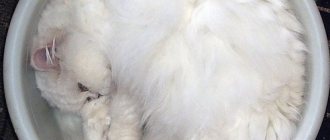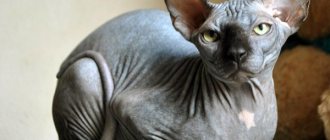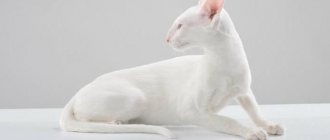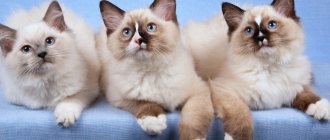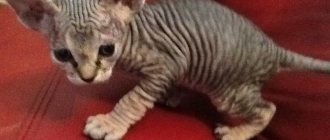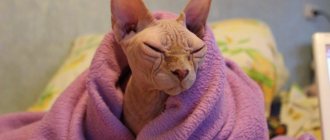Cat hybrids are animals obtained by crossing domestic cats with their wild relatives.
Hybrids are classified according to generations; the first generation is the result of direct crossing of a wild and domestic cat, which is designated F1. As a rule, in the first generation of hybrids all males are sterile, that is, they cannot produce offspring.
To develop a hybrid breed and overcome the sterility of males, hybrid females are brought together with domestic cats, this is how F2 generations are obtained; F3; F4. Naturally, over generations, the characteristics of the wild ancestor are partially lost.
Hybrids older than 4-6 generations are usually no longer considered hybrids. On their basis, a classic domestic cat breed can be formed, as happened with Bengals. In hybrid breeds, individuals of the 4th-6th generation, as a rule, are additionally infused with wild blood, and the process begins all over again.
In hybrid breeds, the cost of kittens depends on the generation of the hybrid. The smaller the generation, the more expensive the kittens are. At the same time, in recognized breeds, hybrids younger than the 4th generation are usually not allowed for exhibitions for safety reasons.
Savannah cat breed
Bristol cat
Kanaani cat
Caraquet cat
Safari cat
Chausie cat
Savannah (asherah)
Savannah breed history: It is known for certain that the first Savannah was born in Pennsylvania on April 7, 1986 as a result of crossing a male Serval and a domestic Siamese cat. This happened at the Suzi Wood Bengal cattery, and the first breeder of the new breed was Judy Frank.
The Savannah breeding program included Egyptian Mau, Oriental and Siamese cats, as well as Bengals and Ocicats. Nowadays, as a rule, only wild servals and existing representatives of the breed are used for breeding.
Judy Frank and her friends and associates Patrick Kelly and Joyce Sroufe wrote the first Savannah standard in 1996, which was accepted by TICA in 2001, and in 2012 the breed was officially recognized.
The breed received its name in honor of the habitat of its wild ancestor - the serval, an African cat living in the savannah.
One of the biggest scandals in the cat world is associated with savannahs. In 2007, the Lifestyle pets company announced the creation, using biotechnology, of the largest and most hypoallergenic breed of domestic cats - the Asher. The company asked 15-25 thousand dollars for the kittens. In practice, it turned out that Savannahs purchased earlier from breeder Chris Szczyrk were passed off as Usher Lifestyle pets, which was confirmed by a DNA test.
At the moment, the Savannah is the most successful and popular hybrid cat breed, recognized by two associations, TICA and ICU.
Savannah F1 individuals are considered the largest domestic cats.
Savannah character: hybrids up to the fourth generation can be aggressive, secretive and unsociable, maintaining “wildness” both in character and appearance. Savannahs are very active and require plenty of space to roam and exercise. Also, cats of this breed are usually very loyal to one owner.
Bristol (Bristol cat)
Bristol history of the breed: Everything is complicated with the Bristol cat; it is unknown whether this breed ever existed, or is it a figment of rumors and imagination. Cats with this name appear in the sources twice.
In 1972, the American nursery Havenwood announced the creation of the developing Bristol breed. The ancestor of the Bristol cat was an Australian street cat imported to the United States by the family of an American soldier. The homely daughter of this cat ended up in a nursery, where she was bred with a Burmese male. The kittens turned out to be cute and Havenwood decided to continue working on them. Probably the end result was something similar to the Australian Mist breed.
Then the breed is lost, and is mentioned again in the 80s in connection with work on Bengals. A certain cat named Cajun apparently took part in the formation of the Bengals. The Cajun had a specific color characteristic of South American wild cats (ocelot, oncilla, margay) and was probably a descendant from the mating of a representative of one of these species with a domestic cat. The Cajun and his "harem" were located in Texas and were called "Bristol Cats". Perhaps they were relatives of the Bristols mentioned in 1972.
The Bristols were never recognized by either system, and most likely ceased to exist as part of the Bengal gene pool.
The origin of the name Bristol cats is unknown.
Bristol character: Bristols are affectionate and very smart cats.
Wild cats: what if you try a hybrid?
Contents hide
Wild cats: what if you try a hybrid?
Dear readers, today we are completing a series of articles about wild cats, which, in principle, can be tamed and kept as pets. For our part, we support the point of view of authoritative expert experts: no matter how beautiful and exotic wild forest cats are, the best place for them is the wild or, in extreme cases, a zoo. But what should you do if you really want to show off your originality in front of your colleagues, friends and neighbors, but you’re afraid to bring a lynx or serval into your house? There is an exit!
And the solution is quite simple! Zoologists, breeders, scientists and simply experimenters did not give up attempts to cross wild and domestic cats. Some offspring were not very viable (like, for example, the children of a lynx and a domestic cat), some animals were even born with serious genetic abnormalities and mutations. But there were also successful experiments that led to stunning results! As a result, the world saw the most beautiful cats of the so-called hybrid breeds. We will now briefly tell you about them - who is who.
The Savannah cat and the Asherah cat are the result of crossing a Serval and a domestic cat.
Chausie (Housie) is the result of crossing a jungle cat and a domestic cat.
The Jungle Bob is the result of crossing a Jungle Cat and a Pixie Bob cat.
The Bengal cat is the result of crossing an Asian leopard cat and a domestic cat.
The Safari cat is the result of crossing a Geoffroy cat and a domestic cat. The Egyptian Mau (the fact is disputed) and Ocicat breeds appeared.
Are hybrid cats right for you? First of all, don't think that you are getting an ordinary domestic cat with an exotic appearance. Sometimes a hybrid may be too good for you - its wild roots will make themselves known! Of course, some hybrid cats will be a little calmer, others a little more active. We may surprise you, but we’ll say: you’re getting not a cat, but a dog in a cat’s guise! But even dogs can be different - for example, a Tibetan mastiff will doze on the sofa for days on end, and a super-energetic border collie will literally force its owner to lose tens of extra pounds!
Approach the purchase of a wild or hybrid cat with extreme caution, weigh your options, evaluate the animal’s temperament, compare your own level of activity and that of your potential pet.
Do not believe many charlatan pseudo-professional sites where information is posted on behalf of “experts” that hybrid cats cannot be good pets, they are too expensive, willful, wild, etc. This is complete nonsense. Sometimes you can find an excuse for such “authors” and “sites” - as a rule, their content is paid for from the funds of environmental organizations and organizations that defend the rights of wild animals. But hybrid cats have nothing to do with it; many animals become wonderful friends and companions.
The value of hybrids is determined by the “generation” - how much “wild” blood remains from the ancestors in a particular kitten. But, be that as it may, these are domestic cats, albeit with their own characteristics of care and maintenance. Choose from those that you like. True, such kittens are quite expensive, but they are worth it - forgive the pun!
Original publication: Legal Small Exotic Cats That Are Kept As Pets. Author: Melissa Smith Source and photo:
Kanaani (Canaani, Canaan cat)
Kanaani breed history: The Kanaani breed was created in Jerusalem in the 90s. The famous sculptor of Russian-Israeli origin Doris Pollacek decided to create a cat breed similar to the wild ancestor of all domestic cats - the steppe (Libyan) cat. For this purpose, spotted Orientals, Bengals and the actual Libyan wild cats were used in the Kanaani breeding program.
Cats from the Pollachek cattery “Ha Jeruschalimi” were sold to catteries in the USA and Germany. It was in Germany that the breed standard was developed, which was adopted by the WCF in the early 2000s. Since 2008, the breed has been “closed”, that is, the infusion of both wild blood and crossing with cats of other breeds is prohibited.
The breed is named after Canaan, the historical name of the area where the state of Israel is now located.
Kaanaani Personality: Canaanis are active, affectionate, and love to hunt.
Caraquet (caracat)
Caracat breed history: The Caracat is a hybrid of a domestic cat and a caracal. The caracal was previously classified as a lynx, but recently it was separated into a separate genus due to genetic and morphological characteristics that bring it closer to both the puma and the serval.
In 1998, an accidental crossing of an ordinary domestic cat and a male serval occurred at the Moscow Zoo, resulting in the birth of the first caracat. However, the kitten did not fall into the hands of felinologists and was not used in breeding work.
In the United States, at the beginning of the 2000s, two respected and authoritative breeders, Joy Gesinger and Alisson Navarro, were involved in breeding caraquets. It was thanks to Joy that the caraquetas received experimental status in TICA. However, Gesinger died in 2014, and Navarro stopped her work on the breed around the same time for unknown reasons.
However, in 2014, the baton was intercepted by the Russian cattery Cataleya; its owner Irina Nazarova positions herself as the creator of the breed, claiming that she independently obtained the F1 caraquet. However, in 2020, regardless of Nazrova, caraketas were obtained in Kyiv by savannah breeders Anna Kuzmina.
It is unknown which domestic cats Nazarova used in her work, while in nurseries in the USA and Ukraine matings with the Serengeti and Abyssinians were used.
Thanks to Nazarova’s efforts, the breed received experimental status in the ICU.
The name Caracat comes from the merger of the English names of its ancestors: caracal+cat.
Caraquet character: Caraquets are friendly, affectionate and loyal to their owner. However, hybrids of the first generations can retain wild traits: aggression and secrecy.
LiveInternetLiveInternet
Although wise nature instinctively provides for enmity between species, which prevents them from interbreeding, animals raised together can often overcome it. This is how hybrids of big cats are born - liger, tigron and leopon. Since the beginning of the 19th century, zoos and traveling menageries have bred these unusual creatures in order to attract the attention of the public. Although the first hybrids were most likely born by accident, as a result of the fact that animals, due to lack of space or for convenience, were kept in the same cages, while no one thought that cats could and would mate. However, the desire for procreation inherent in nature can be stronger than the interspecies enmity inherent in it.
On the other hand, even Pliny was convinced of the ability of big cats to interspecific mating and generate various hybrids, explaining this by the fact that different species were forced to come to a single watering hole, where they could enter into various kinds of relationships with each other. However, in reality, cases of interspecific crossing in nature are still extremely rare.
The first recorded interbreeding was in India in 1837, when the princess of the Indian state of Jamnagar presented a big cat hybrid to Queen Victoria. Scientific experiments on hybridization began before the First World War
Nowadays, although in large zoos they try to prevent interspecific crossing, it is nevertheless practiced in private collections and institutes studying the behavior and reproductive functions of animals, not to mention the idea that there is a place to breed domestic large ones. cats.
Tigron (also known as tigeon, tigrolev, tiglon), Panthera tigreo, is the most common hybrid, a cross between a male tiger and a female lioness. In fact, tigers and lions are very close and their species separation from an evolutionary point of view occurred quite recently. Males resulting from such crossing, as a rule, are not capable of further reproduction, but females, which is extremely uncharacteristic of hybrids, can mate with both a tiger and a lion, thus creating new hybrids. Cubs in such litters are usually larger than their parents and bear the characteristics of both species: a dark tone of color, a red mane (short and less dense), stripes paler than those of tigers and a lightened muzzle.
The liger (aka liger), Panthera leogris, is, on the contrary, a cross between a male lion and a female tiger. The liger looks like a giant tiger with blurry stripes, some males have a lion's mane, but, unlike lions, ligers know how and love to swim. Female ligers, like female tigons, are capable of giving birth. Ligers are the world's largest feline and are even thought to bear a significant resemblance to the prehistoric cave lion. Nowadays, in the zoo of the Institute of Rare and Protected Species in Maimi, there lives a male whose height reaches three (!) meters. There are also ligers in our country's zoos. In 2004, in Novosibirsk, for example, two of their cubs were born at once.
Leopon is a creature born from the crossing of a lion and a leopard. Leopon largely retains the appearance of a lion - a mane and a tuft on the tail, but is inferior to it in size and has the spotted coloring inherited from the leopard throughout the body.
It is noteworthy that, in addition to external characteristics, hybrids inherit their “character traits” and behavior patterns from both parents, which often leads to “emotional problems” and difficulties in species self-identification. The main conflict lies in the radical difference between the habits of lions living in a pride and the instincts of a lone tiger. Even the “vocabulary” of hybrids can be mixed - tigers “puff”, lions roar, and purebred parents themselves may be embarrassed by the appearance of hybrid offspring. In addition to “emotional instability,” hybrids are much more susceptible to disease, and their breeding does not in any way contribute to the preservation of species that are already quite rare these days. Therefore, despite all the interest that hybrids represent, interspecific crossing is often not welcomed or even banned.
https://skillopedia.ru/material.php?id=3587
Safari (safari cat, criollo, aplausa)
Safari breed history: Safari is a hybrid of a domestic cat and a Geoffroy wild cat, a representative of the South American fauna. For the first time, such a hybrid was obtained in the 1970s at the University of Washington, where research was carried out on feline viral leukemia (for the same reason, Bengals appeared).
However, work on the safari at the university was soon stopped; there was information that it was continued by American felinologists, but today the fate of the breed is unknown. Most likely, due to genetic difficulties, the breed ceased to exist, but some individuals could remain with their owners.
Safari character: Safaris are independent, intelligent and affectionate, but can also exhibit wild traits.





